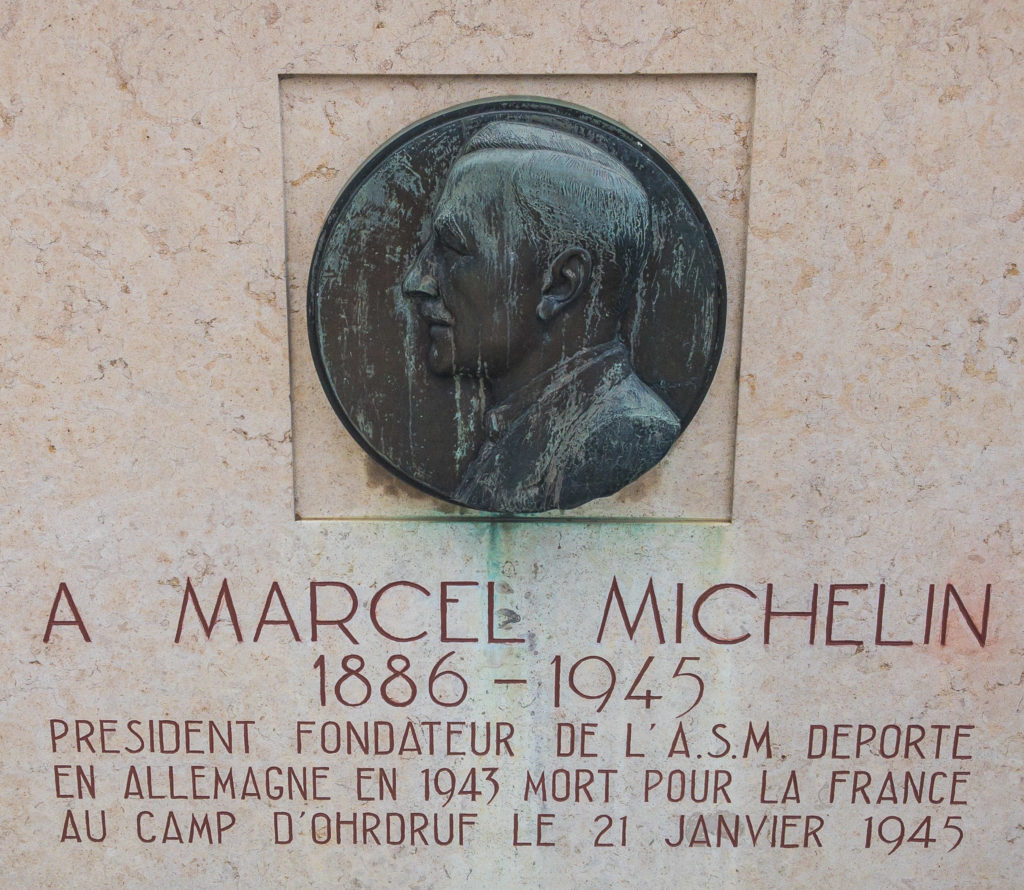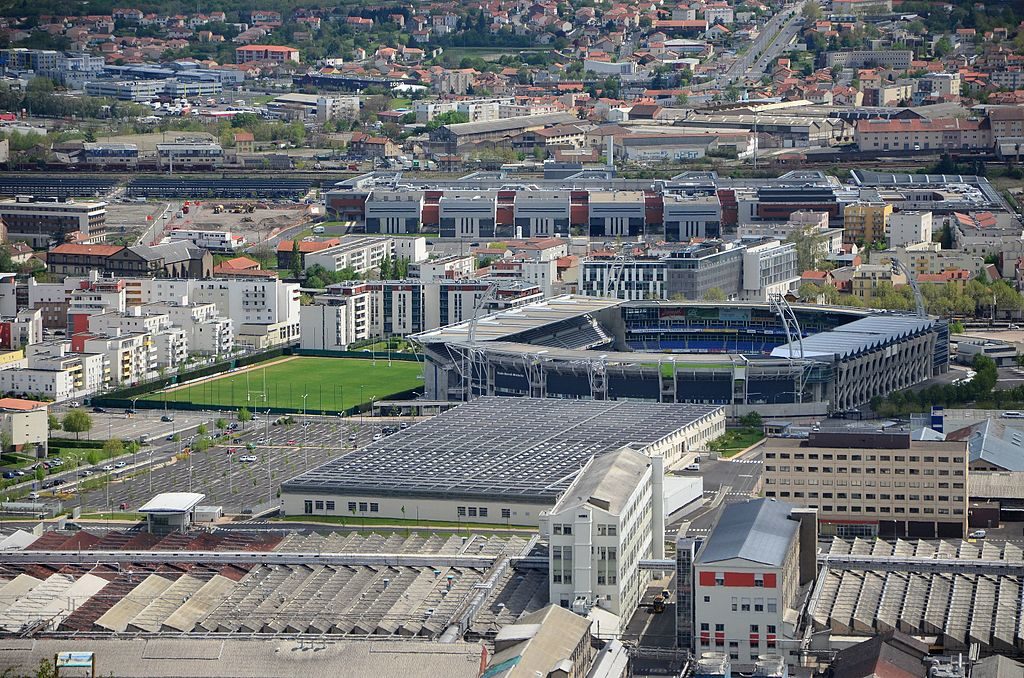
The European Challenge Cup Comes Back to the Deep Heart of France
There's a huge party in Clermont-Ferrand this weekend. Yesterday the players of the ASM Clermont Auvergne rugby team came home from England to celebrate their victory over La Rochelle (by a dominating score of 36 - 16) to claim this year's Challenge Cup. The annual tournament brings together 18 of the best clubs from three major leagues -- England's Premiership Rugby, France's Top 14, and the international Pro 14 -- plus 2 more teams from the Contintental Shield tournament representing the second tier of European Clubs.
It was an exciting match for Clermont Auvergne fans. Greig Laidlaw (from Scotland) accounted for half of all the ASM's points, and the Guardian newspaper described the action as " a Barbarians-style cavalcade of ambitious offloads and daring thrusts interspersed in equal measure with errors and colossal hits". It's the third such European championship title for ASM Clermont Auvergne, tying them with England's Harlequins for the most wins ever. (The crowd on hand was a record, too, with more than 28,000 people present in the stadium at Newcastle.)
...taking me back to a September Saturday
I would have loved to be in that crowd, but I had to follow the match online. It all took me back to the last time I did get to see the ASM team play in person. My heart beats a little faster every year as September approaches – I don’t regularly watch any other sports on TV the rest of the year, but when college football season starts every autumn I am there for hours every Saturday! So on a September Saturday last year in the deep heart of France, I was excited to see first-hand what gets people there excited: the opening game of the Top 14 Rugby League’s season in Clermont-Ferrand.
The #YellowArmy of the ASM
The team is called “ASM Clermont Auvergne”. “ASM” stands for “Association Sportive Montferrandaise” (it used to mean “Association Sportive Michelin” in honor of the company that founded the club, but the name was changed in 1922 when the governing body of French rugby got fed up with the number of purely “promotional” team names).
I’ve written about it before on this blog, when the club won the National Championship of France in 2017, defeating Toulon by a score of 22-16. Local papers reported that 40,000 people had gathered in the Place de Jaude exploded in celebration, and seismologists in the local observatory noted a sharp spike in their records at the exact moment the final whistle blew in Paris!

A rugby museum
That victory, and many others over the last century, are celebrated in a new museum called the “ASM Experience.” Occupying a suite beneath one end of the stadium in Montferrand (across the street from the excellent “Aventure Micheln” museum devoted to that company’s rich history), the “ASM Experience” lays out the club’s illustrious, sometimes frustrating history going back to its origins in 1911.


The ASM long held the reputation of being one of the very best teams in France, but never quite capable of winning the championship. In fact, they made it to the championnat game of the season 10 times between 1936 and 2009 without actually taking home the title. They claimed their first national championship in the French “Top 14” league in 2010 and burst onto the broader European scene, playing (but losing) in the finals of the Coupe d’Europe three times, then winning the championship of France again in 2017.
But whether they win that final game or not in any given year, ASM Clermont Auvergne has established itself in the conversation about the best rugby teams in Europe. I was reminded of their celebrity status in 2010, when on a business trip to Paris the weekend before the final, I happened to be on the same airplane as most of the ASM players. In those days, you had to have your passport checked on arrival at the Paris airport. The first player stepped up to the booth, and the bored-looking officer started his perfunctory scan of the guy’s passport… and then the light came on! The officer looked up to the player’s face, and it was as though Elvis or Charles de Gaulle himself had come to the window. All the other officers were called over to shake hands and meet everyone on the ASM travelling squad as we all watched and hoped we would make our connecting flights.

The Michelin Legacy
They were amateurs in the beginning. The club was launched by Marcel Michelin, a dramatic figure in his own right. His father was André Michelin, one of the founding brothers of the great Michelin tire empire. Marcel worked for the company and decided in 1911 that the men working in Michelin’s factories in Clermont-Ferrand needed an outlet during their time off; he founded the Association Sportive Michelin, an organization that still offers (106 years later) programs in every imaginable sport from swimming to judo to boxing.


When the Second World War came, Marcel took an active role in the French Resistance movement. He and his son were ultimately captured by the Nazis and deported to the horrible camp at Buchenwald; both died there. Marcel’s rugby team endured, though, rising to higher and higher levels in the French leagues. The fine small stadium in Montferrand still bears his name, and the management of the team continues to be drawn from the senior executive group at the Groupe Michelin.
All this history is detailed (with signs in French and in English) in the “ASM Experience” museum. It’s also an exposition about rugby – how the teams are organized, what it takes to play each position, and what the rules of the game mean. There are several multimedia stations with films of great plays and decisive moments from past games. And (for the price of an additional ticket) there are even guided tours of the stadium and the locker rooms to take you behind the scenes and give you a visceral sense of what life is like for the players of ASM Clermont Auvergne.

Kicking off the 2018 season: ASM vs Agen
So I was happy to have a front-row seat in the Stade Marcel Michelin earlier this month when ASM Clermont Auvergne kicked off a new season against the visiting team from Agen. The day had started chilly and gray, so I took a jacket, but as game time approached the clouds blew away and the sun cast the stadium in warm autumnal light.

I arrived early, but fans were already lined up at the booths for food and beer. Some of them had incredible costumes – Viking horns, flowing blue and yellow caftans, bright yellow sneakers, and clown pants in the team’s colors. A rowdy and very ragged “spirit band” played and led the singing inside the stadium.
During the pre-game warm-ups, many of the people in the crowd went down to the railing around the field to greet friends and smoke cigarettes. Bibendum (“Mister Bib”, the official mascot of the Michelin Tire Company) made a complete circuit around the field, shaking hands with fans.

Eric Decromieres (a member of Michelin’s Executive Committee who’s now taken over as President of the ASM) came out on the pitch to make some opening remarks for the new season. In typically self-deprecating French fashion, he started by apologizing (more than once!) for the “mediocre” play of the team last year, promising better things for the 2018-2019 campaign.

The game itself started slowly, with both Agen and the ASM players making tons of early-season errors. Both teams scored in the first few minutes, and I got a better appreciation for the physicality of rugby. Several players on both sides are giant men – Clermont’s Loni Tuhila (from New Zealand) is 5’ 10” (1.8 meters) tall and weighs 275 pounds (125 kg), while Sitaleki Timani (born in Tonga, trained in Australia) is 6’ 8” (2.03 meters) and 260 pounds (118 kg)!
As in soccer, American football, and other “field-oriented” sports, there are long stretches in a rugby game where not much seems to be happening – punctuated by incredibly intense moments of struggle and collision that bring spectators to their feet. This is a rough sport, with big men colliding at high speeds wearing only shorts and a t-shirt. (Two or three players on each side – no more than that – were wearing lightly padded helmets, although I’ll be damned if I can see how that provides much protection for their heads in a game like this.)

The refree (arbitre in French) got a full measure of abuse from the crowd in the first half when he looked at the video replay and overturned an essaie (“try”) that would have put ASM ahead. I learned some new French vocabulary from the people on the row behind me. “Aaaaay, on est ou, la ? Ça commence mal…et en plus il nous sanctionne ? » This was followed by a suggestion that seems anatomically unlikely to me, and it made the Agen supporters sitting beside me cringe.
The score at halftime was Agen 16, ASM Clermont Auvergne 15, so there was some inevitable grumbling in the stands during the break. When they returned to the field, though, it was clear something motivational had happened to the ASM players; they exploded for 2 quick essaies in the first 7 minutes of the second half and ended up with one of the biggest wins in club history, with a final score of 67-23.

In their seats until the end
Sometimes when that happens in an American college game, even reasonably loyal hometown fans start heading for the exits long before play ends, hoping to get to their cars before traffic becomes too intense. On this fine late summer evening in the deep heart of France, though, I saw no one leaving early. The rowdy little band decamped with their instruments to the parking lot and fans stood in little groups talking about prospects for the season ahead…and somewhere, in downtown Clermont, the statue of the Celtic warrior Vercingetorix had his sword replaced with the official flag of the ASM!
Have you attended sporting events in France? How would you compare the atmosphere with your experience in other countries? Was there something you particularly enjoyed about the experience? Tell us about it in the comments section below – and please take a second to share this post with someone else who loves the places, culture, history, and people of France.



Great piece, thank you. The ‘helmets’ are to protect the ears in the scrum, which very easily get deformed! A classic snapshot into life in France here – you cover the culture so well.
Thanks for filling me in about the helmets — that makes sense! (Thanks, too, for your very kind comments.)
Really enjoyed this, Richard. I didn’t know the history of ASM until now. So interesting!